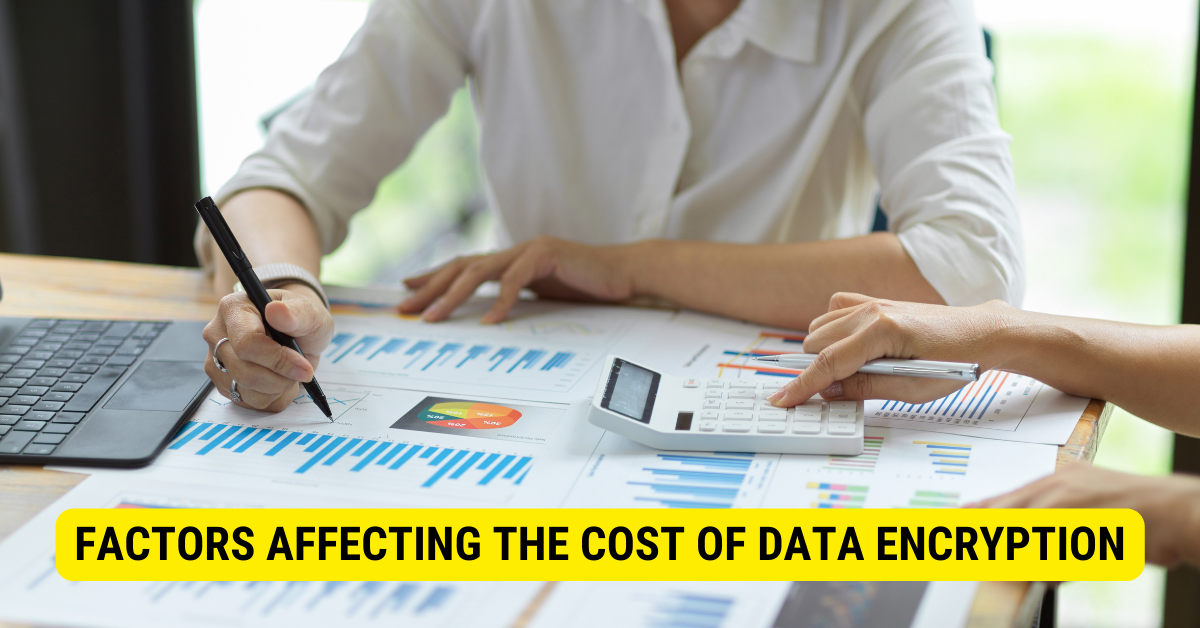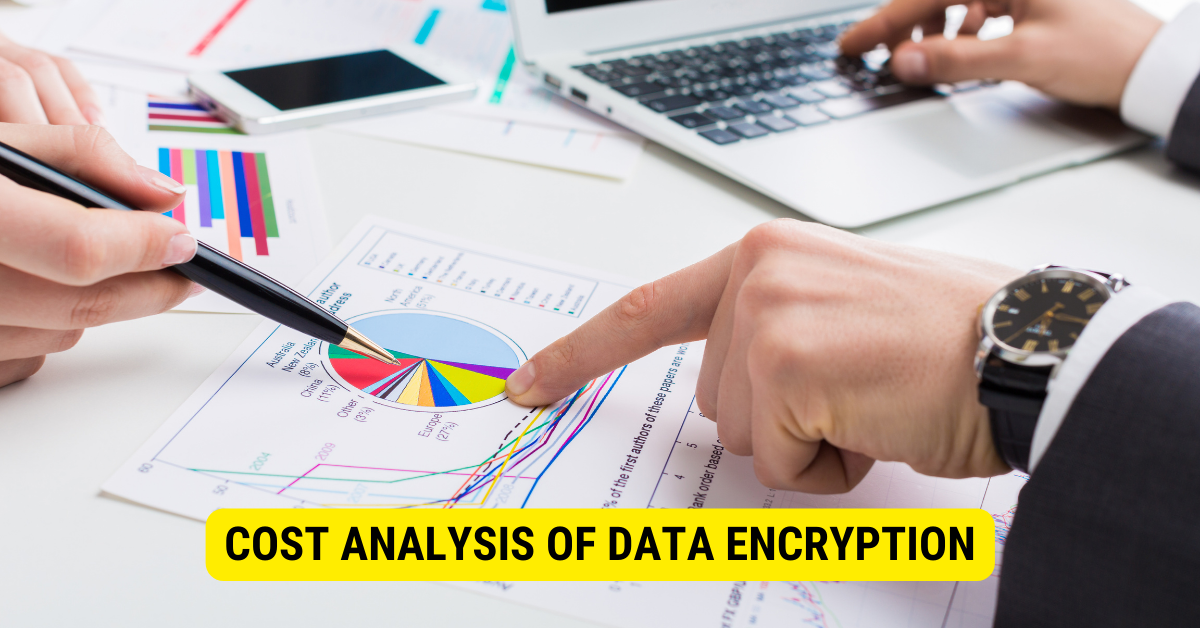The cost of encrypting data can vary depending on several factors such as the specific encryption method used, the amount of data being encrypted, the complexity of the encryption process, and the resources required to implement and maintain the encryption system. Additionally, the cost may include expenses related to hardware and software purchases, training personnel, and ongoing maintenance and support. Due to these variables, it is not possible to provide a precise cost without more specific details about the encryption requirements.
In today’s technologically advanced world, data security is of utmost importance. Protecting sensitive information from unauthorized access has become a top priority for businesses and individuals. Data encryption plays a crucial role in safeguarding data from potential security breaches. However, when considering data encryption, one question arises: “How much does it cost?
Understanding Data Encryption
Data encryption converts plaintext data into scrambled ciphertext, making it unreadable to unauthorized users. This ensures that even if the data falls into the wrong hands, it is virtually impossible to decipher without the encryption key. Encryption provides an extra layer of security to protect sensitive information, such as passwords, financial records, and personal data.
We will delve deeper into the world of data encryption and explore how it works its importance, and the various ways it can be implemented.
What is Data Encryption?
Data encryption involves using an algorithm and an encryption key to convert plain text data into ciphertext. The algorithm performs mathematical operations on the data, making it difficult to interpret without the decryption key.
There are different types of encryption algorithms, including symmetric and asymmetric encryption. Symmetric encryption uses the same key for encryption and decryption, while asymmetric encryption uses a pair of keys – a public key for encryption and a private key for decryption.
Modern encryption algorithms, such as Advanced Encryption Standard (AES) and RSA, are designed to secure and resist attacks. These algorithms use complex mathematical functions and key sizes, making brute-force attacks practically infeasible.
Importance of Data Encryption
Data encryption is crucial for maintaining privacy and confidentiality. It helps prevent unauthorized access, ensuring that sensitive information remains secure. Encryption can protect against various threats, such as data breaches, identity theft, and unauthorized surveillance.
Encryption holds significant importance for businesses that deal with sensitive information, including financial institutions and healthcare providers. Such organizations have a crucial obligation to prioritize data encryption in order to meet regulatory obligations and build trust among their clientele.
Encryption safeguards when data is transmitted over networks or stored in the cloud. It ensures that the data remains unintelligible to unauthorized individuals even if intercepted.
Furthermore, data encryption can also be beneficial for individuals. Encrypting personal data on devices like smartphones and laptops can provide an extra layer of protection in case of theft or loss.
It is worth noting that encryption alone is not a foolproof solution. It should be used with other security measures, such as strong access controls, regular software updates, and employee training on cybersecurity best practices.
As technology continues to advance, the reputation of data encryption becomes increasingly evident. With cyber threats becoming more sophisticated, encryption plays a crucial role in safeguarding sensitive information and ensuring the privacy and security of individuals and organizations alike.
Factors Affecting the Cost of Data Encryption

The cost of data encryption can vary depending on several factors. Organizations need to consider these factors when implementing encryption solutions.
Data encryption plays a vital role in protecting sensitive information from unauthorized access. However, the cost associated with implementing encryption can vary based on various factors, such as the type of data to be encrypted, the encryption software used, and the complexity of the encryption process.
Type of Data to be Encrypted
The type of data that requires encryption can significantly impact the cost. Different data types may require different levels of encryption, which can influence the complexity and cost of the encryption process. Highly sensitive data, such as financial records or personally identifiable information (PII), may require stronger encryption algorithms, leading to higher costs.
For example, financial institutions dealing with large volumes of transactional data must ensure their encryption methods are robust and comply with industry standards. This level of encryption requires sophisticated algorithms and stronger key management systems, which can increase the overall cost.
Encryption Software Used
The choice of encryption software can also affect the overall cost. Some encryption software solutions may require a one-time payment, while others may have a subscription-based pricing model. The scalability and features the encryption software offers can also influence the cost. Organizations should carefully evaluate their encryption software options to find a solution that meets their security requirements within their budget.
Furthermore, organizations may need to consider the compatibility of the encryption software with their existing IT infrastructure. Integration complexities and the need for additional customization can add to the overall cost of implementing encryption.
The Complexity of the Encryption Process
The complexity of the encryption process can impact the cost. More complex encryption algorithms may require additional computational resources, leading to higher expenses for hardware infrastructure. Additionally, complex encryption processes may require specialized personnel to implement and maintain the encryption system, adding to the overall cost.
Organizations must also consider the impact of encryption on system performance. The encryption process can introduce a certain level of overhead, potentially affecting the speed and efficiency of data processing. Mitigating these performance issues may involve investing in high-performance hardware or optimizing the encryption algorithms, which can further increase the cost.
Moreover, the complexity of managing encryption keys is another factor to consider. Proper key management is crucial to ensure the confidentiality and integrity of encrypted data. Organizations may need to invest in key management systems or employ dedicated personnel to handle key generation, storage, and distribution, which can contribute to the overall cost of data encryption.
In conclusion, the cost of data encryption is influenced by various factors, including the type of data to be encrypted, the encryption software used, and the complexity of the encryption process. Organizations must carefully evaluate these factors to determine the most cost-effective encryption solution that meets their security requirements.
Different Methods of Data Encryption
There are various methods of data encryption that organizations can utilize to protect their sensitive information. Data encryption is crucial to cybersecurity, ensuring that data remains confidential and secure from unauthorized access.
Data encryption involves transforming data into an unreadable format using encryption algorithms. The encrypted data can only be accessed by authorized individuals who possess the decryption key. Let’s explore some of the most commonly used methods of data encryption:
Symmetric Encryption
Symmetric encryption involves using the same key for both encryption and decryption. This method is relatively fast and efficient, making it suitable for encrypting large amounts of data. With symmetric encryption, the sender and the recipient share a secret key to encrypt and decrypt the data.
However, the challenge lies in securely exchanging the encryption key between the sender and the recipient. If an attacker intercepts the key during transmission, they can gain access to the encrypted data. To mitigate this risk, organizations often use secure key exchange protocols, such as the Diffie-Hellman key exchange algorithm, to establish a secure communication channel.
Asymmetric Encryption
Asymmetric encryption, also denoted to as public-key encryption, utilizes a key pair consisting of a public key for encryption and a private key for decryption. This approach tackles the issue of key exchange encountered in symmetric encryption. The public key is widely disseminated and can be employed by anyone to encrypt data, whereas the private key remains confidential and is utilized by the recipient to decrypt the data.
Asymmetric encryption provides a more secure solution for data encryption, as there is no need to share the private key. This eliminates the risk of key interception during transmission. However, asymmetric encryption can be slower than symmetric encryption due to the algorithm’s complexity.
One of the most widely used asymmetric encryption algorithms is the RSA algorithm, which is based on the mathematical properties of prime numbers.
Hash Functions
Hash functions are cryptographic algorithms that convert data into a fixed-size string of characters, known as a hash value. Hash functions are commonly used to validate data integrity and ensure it has not been tampered with.
When data is hashed, it undergoes a one-way transformation, meaning it cannot be reversed to obtain the original data. Even a minor change in the input data will result in a completely different hash value. This property makes hash functions ideal for verifying the integrity of data.
While hash functions are not used for encryption, they are an important component of data security. They are widely used in various applications, such as password storage, digital signatures, and data integrity checks.
Some commonly used hash functions include MD5 (Message Digest Algorithm 5), SHA-1 (Secure Hash Algorithm 1), and SHA-256 (Secure Hash Algorithm 256-bit).
Overall, data encryption plays a crucial role in safeguarding sensitive information. By employing the right encryption methods, organizations can ensure their data’s confidentiality, integrity, and availability, thereby protecting themselves and their stakeholders from potential security breaches.
Cost Analysis of Data Encryption

When considering the cost of data encryption, organizations must assess both the initial setup costs and the ongoing maintenance costs. However, it is important to note that the benefits of data encryption far outweigh the expenses incurred.
Initial Setup Costs
The initial setup costs of data encryption may include purchasing encryption software, hardware infrastructure upgrades, and training personnel. Organizations should also consider any consulting or implementation fees incurred during the setup phase. The encryption system’s complexity and deployment scale can impact the initial setup costs.
For instance, organizations may need to invest in state-of-the-art encryption software that can handle large volumes of data and provide advanced security features. Additionally, hardware infrastructure upgrades might be necessary to support the encryption process effectively. This could involve purchasing new servers or upgrading existing ones to ensure optimal performance.
Furthermore, training personnel on properly using and managing the encryption system is crucial. Organizations may need to allocate resources for comprehensive training programs to ensure that employees understand the encryption protocols, know how to handle encrypted data and know potential security risks.
Maintenance Costs
Once the encryption system is implemented, ongoing maintenance costs come into play. These costs may include software updates, license renewals, hardware maintenance, and the salaries of IT personnel responsible for managing and monitoring the encryption system. It is essential to budget for these expenses to ensure the sustainability and effectiveness of the data encryption process.
Regular software updates are crucial to address any vulnerabilities or weaknesses that may arise over time. These updates enhance the encryption algorithms and provide patches for any potential security breaches. Organizations must allocate resources to stay updated with the latest encryption software versions to ensure maximum protection.
License renewals for encryption software are another aspect of maintenance costs. Organizations must factor in the cost of renewing licenses to ensure continuous access to critical encryption features and support from the software provider.
In addition, hardware maintenance is essential to keep the encryption infrastructure running smoothly. This may involve regular inspections, repairs, and upgrades to guarantee optimal performance and minimize the risk of hardware failures that could compromise the encryption process.
Lastly, organizations must consider the salaries of IT personnel responsible for managing and monitoring the encryption system. These professionals play a crucial role in maintaining the integrity and effectiveness of encryption measures. Their expertise and constant vigilance are vital to detect and respond to potential security threats promptly.
Potential Cost of Not Encrypting Data

While data encryption comes with a cost, the potential cost of not encrypting data can be significantly higher. Data breaches can result in financial losses, legal liabilities, reputational damage, and loss of customer trust. Organizations must consider the potential consequences and compare them to the cost of implementing data encryption measures.
Financial losses can occur due to theft of sensitive information, such as credit card details or trade secrets. Organizations may face legal liabilities if they fail to protect customer data adequately, leading to lawsuits and regulatory penalties. Reputational damage can result from negative publicity surrounding a data breach, leading to a loss of customer trust and loyalty.
Furthermore, the long-term consequences of a data breach can be far-reaching. Organizations may experience declining business opportunities, difficulty attracting new customers, and increased costs associated with rebuilding their reputation and implementing stronger security measures.
Key Takeaways
- Data security is crucial today, and data encryption is vital in safeguarding sensitive information.
- Data encryption converts plaintext data into scrambled ciphertext, making it unreadable without the decryption key.
- Encryption protects against data breaches, identity theft, and unauthorized surveillance.
- Factors affecting the cost of data encryption include the type of data, encryption software used, and complexity of the encryption process.
- Different encryption methods include symmetric encryption, asymmetric encryption, and hash functions.
- Initial setup costs of data encryption include software purchase, hardware upgrades, and personnel training.
- Maintenance costs include software updates, license renewals, hardware maintenance, and IT personnel salaries.
- The potential cost of not encrypting data can be higher, including financial losses, legal liabilities, and reputational damage.
- The cost of encrypting data varies depending on infrastructure scale, encryption methods, and integration/maintenance needs.
- Ongoing costs of data encryption may include key management and system upgrades.
FAQs
How much does it cost to encrypt data?
The cost of encrypting data can vary depending on several factors, including:
- Scale and complexity: The size and complexity of your data infrastructure can impact the cost of implementing encryption. Larger systems or complex architectures may require more resources.
- Encryption methods: Different encryption methods and algorithms may have varying costs. Some solutions may require purchasing licenses or investing in specialized hardware.
- Integration and maintenance: Consider the cost of integrating encryption into existing systems and ongoing maintenance requirements.
Are there any ongoing costs associated with data encryption?
Yes, there can be ongoing costs associated with data encryption, including:
- Key management: Managing encryption keys often requires dedicated resources, including personnel or key management systems.
- System upgrades: As encryption technologies evolve, upgrading systems and software may be necessary to maintain optimal security.
Conclusion
Ultimately, the cost of data encryption depends on various factors, such as the type of data, the encryption software used, and the complexity of the encryption process. Organizations must carefully evaluate their security requirements, budget constraints, and risk tolerance to determine the most cost-effective data encryption solution. Investing in robust data encryption measures can provide peace of mind and protect against the potentially devastating consequences of data breaches.
